

They both appear to perform about the same, but the raw disk sizes are different.
G4 mac mini memory serial#
Side note: I bought two of the exact same drives.ĪDATA SU800NS38 128GB, same firmware (Q0125D), similar serial numbers. I expected the IDE interface to be a large bottleneck, so I didn’t expect those sorts of speed increases. Create-Read-Delete-Create-Read-Delete-įiles /sec %CP /sec %CP /sec %CP /sec %CP /sec %CP /sec %CP Version 1.97 -Sequential Create-Random Create. Machine Size K/sec %CP K/sec %CP K/sec %CP K/sec %CP K/sec %CP /sec %CP Version 1.97 -Sequential Output-Sequential Input-Random-Ĭoncurrency 1 -Per Chr-Block-Rewrite-Per Chr-Block-Seeks. The partitioning and syncing was relatively straightforward, but keep in mind for NewWorld PowerPCs, extra work is needed to make the bootstrap partition (#2) actually bootable, using hattrib to essentially do the following: Let me reiterate: at this point I was going from SATA to M.2 to 44-pin IDE to 40-pin IDE to USB. The latter involved cannibalizing an old IDE CDROM to IDE enclosure, removing all but the PCB (because of the layout of the 44-pin to 40-pin adapter), but once I had that worked out, I attached the USB device to the Mac Mini. What I ended up doing was 44-pin to 40-pin, then 40-pin to USB. I could have done the same with a G4 tower, but that’s buried in a closet.
G4 mac mini memory install#
My first idea was to use a 44-pin laptop IDE to 40-pin regular IDE adapter I had, install it in an old spare x86 machine I had, boot Finnix, recreate the partitions and sync from machine to machine.īut mac-fdisk is only available on PowerPC, so that was out. The G4 Mac Minis have no room for expansion (the drive and a single stick of memory barely fit in the case as is).

Migrating the hard drives was a bit of an ordeal. I ordered two from Amazon, as well as two of literally the cheapest 128GB M.2 SATA drives available ($52 each on sale at the time). The difference is just price and how long you want to wait for them to arrive. They’re available from several outlets ( Amazon, eBay, AliExpress, etc), but all appear to be the same base manufacturer. SD to IDE adapters exist and I’ve tried a few over the years, but compatibility tends to be terrible, and the interface is slow.īut the other day, I found something I didn’t expect to exist: an M.2 SATA (up to 2280 length) to 44-pin IDE adapter, housed in a 2.5” enclosure.Īnd from what I read at the time, supposedly they worked well. SSDs really didn’t exist until the SATA era.ĬompactFlash to IDE adapters are available, but most of the ones I’ve seen are “loose” (not in a form factor emulating a standard physical drive size), and besides, CompactFlash is basically obsolete too. The drives are standard laptop-style 2.5” 44-pin IDE drives. Inez’s upgraded hard drive is “only” 7 years old and looks to be in good shape, but it will fail someday. I checked leo’s original 12-year old hard drive SMART data, and its seek failures were so high, I’m surprised it’s still running. IDE hard drives are not manufactured anymore, and they will eventually fail, being constantly spinning mechanical platters. Leo is a stock 1.2GHz G4 and an 80GB HDD.īut I’ve been thinking about their longevity lately, and not just because Debian and Ubuntu are dropping the 32-bit PowerPC architecture.
G4 mac mini memory upgrade#
Inez is the more powerful of the two, with a 1.4GHz G4 and a 320GB 2.5” IDE HDD from an upgrade in 2010. One of the nice things about the G4 Minis is they are very power efficient for the period – about 12 watts at idle – so I treat them as always-on servers. My two G4 Mac Minis ( leo and inez – the home network uses Futurama characters for a naming scheme) were released in 2005, and for the most part, they have been running 24/7 since then, usually for Finnix builds. Instead, I’m giving them solid state drives. I have two PowerPC G4 Mac Minis which have been in service since they were released in 2005.


 0 kommentar(er)
0 kommentar(er)
